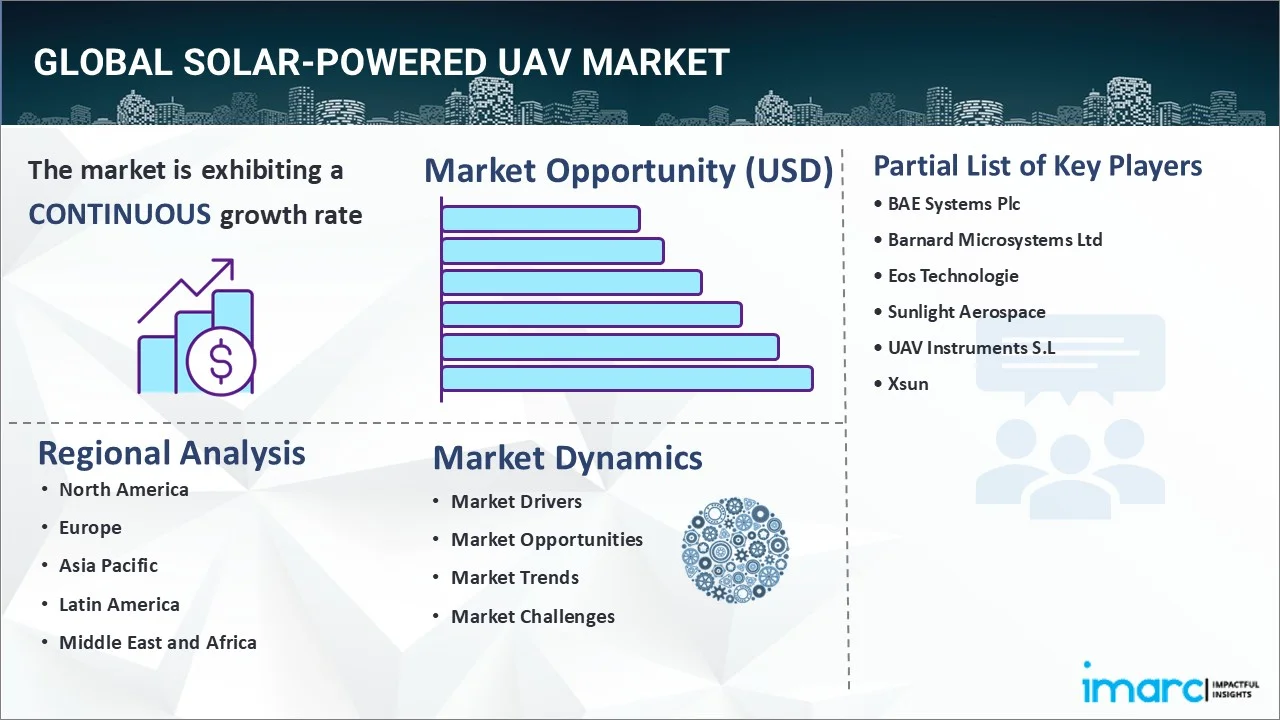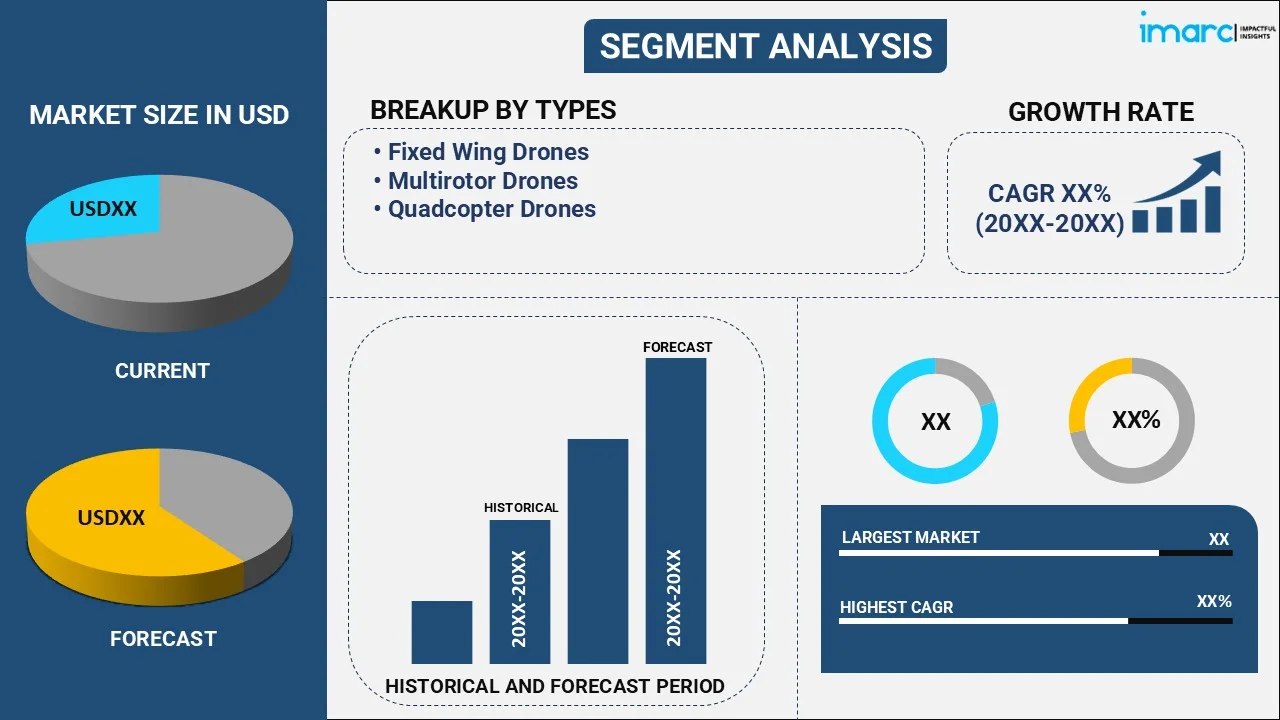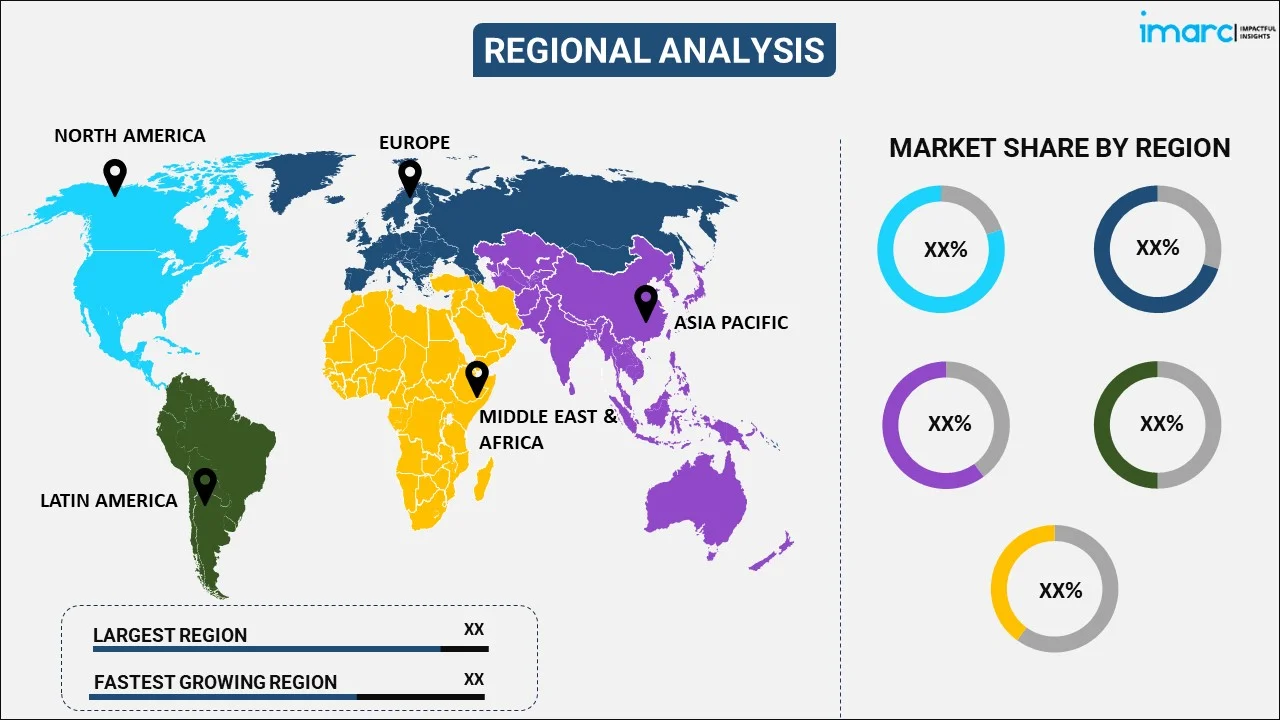
Solar-Powered UAV Market Report by Type (Fixed Wing Drones, Multirotor Drones, Quadcopter Drones), Range (Less Than 300 KM, More Than 300 KM), Component (Propulsion System, Airframe, Guidance Navigation, Control System, Payload), Mode of Operation (Semi-Autonomous, Autonomous), Application (Defense, Commercial), and Region 2025-2033
Global Solar-Powered UAV Market:
The global solar-powered UAV market size reached USD 401.0 Million in 2024. Looking forward, IMARC Group expects the market to reach USD 867.3 Million by 2033, exhibiting a growth rate (CAGR) of 8.5% during 2025-2033. The increasing demand for drone services for various commercial applications and extensive research and development (R&D) activities are primarily driving the market growth.
|
Report Attribute
|
Key Statistics
|
|---|---|
|
Base Year
|
2024
|
|
Forecast Years
|
2025-2033
|
|
Historical Years
|
2019-2024
|
|
Market Size in 2024
|
USD 401.0 Million |
|
Market Forecast in 2033
|
USD 867.3 Million |
| Market Growth Rate 2025-2033 | 8.5% |
Solar-Powered UAV Market Analysis:
- Major Market Drivers: The increasing demand for unmanned aerial vehicles (UAVs) in a wide range of end-use applications, including resource exploration and climate monitoring, is primarily catalyzing the growth of the market. Additionally, significant improvements in the military and defense sector and the recent development of UAV drones for asset management and performing dangerous battlefield surveillance operations are acting as another growth-inducing factor.
- Key Market Trends: The extensive usage of solar-powered UAVs in the agricultural sector over traditional surveying methodologies to analyze crop growth, climatic conditions, spray fertilizers, and track soil conditions is creating a positive outlook for the overall market.
- Competitive Landscape: Some of the leading companies operating in the global market include BAE Systems Plc, Barnard Microsystems Ltd, Eos Technologie, Sunlight Aerospace, UAV Instruments S.L, and Xsun, among others.
- Geographical Trends: According to the report, North America exhibits a clear dominance in the market, owing to the widespread product application in the defense and military sectors, extensive research and development (R&D) activities, and the rising utilization in the agricultural industry.
- Challenges and Opportunities: The challenges hindering the market include optimizing energy storage and efficiency in varying weather conditions and ensuring the cost-effective scalability of solar technology for UAVs. However, opportunities lie in reducing reliance on traditional fuels, extending flight durations, and enabling prolonged missions for surveillance, agriculture, and environmental monitoring applications.

Solar-Powered UAV Market Trends:
Increasing Investments in R&D Activities
Technological advancements are stimulating the market. Moreover, various key market players are also increasingly investing in testing activities to launch autonomous aircraft with improved functionality and technologies. For instance, in February 2024, National Aerospace Laboratories successfully tested a solar-powered UAV that can float in the air for days. For over ten days, scientists at the National Aerospace Laboratories, Bengaluru, carried out a series of flight trials of a scaled-down version of the HAPS, a lightweight solar-powered UAV. Similarly, in December 2023, NewSpace Research and Technologies Pvt Ltd.’s solar-powered high altitude pseudo-satellite (HAPS) carried out its first flight, lasting over 21 hours. The development came as a big event to India's plan to have its long-endurance drones capable of flying in the stratosphere. The growing R&D activities and funding in the sector are anticipated to propel the solar-powered UAV industry in the coming years.
Growing Application in Agriculture
The increasing product utilization in the agriculture sector for tasks, such as crop monitoring, surveillance, pest detection, and precision farming, is offering lucrative growth opportunities to the overall market. It offers advantages like extended flight times and reduced operational costs compared to traditional UAVs relying solely on batteries or fuel. Various key market players are extensively investing in research and development activities to improve the functionalities of solar-powered UAVs utilized in the agriculture sector and offer enhanced functionalities. For instance, in January 2024, Sphere Drones, a key player in the drone industry, introduced a self-sustaining mobile drone platform, HubX. This platform enables businesses to collect aerial data across various terrains and remote areas. Additionally, in October 2022, the Indian cricket star launched the camera drone named 'Droni' with advanced features manufactured by Garuda Aerospace. The drone is made for carrying out farming operations, such as pesticide spraying, solar panel cleaning, industrial pipeline inspections, mapping, surveying, public announcements, and delivery services.
Escalating utilization of solar-powered UAVs in Defense
Solar-powered UAVs offer significant potential in the defense sector. In defense applications, they offer enhanced persistence and operational flexibility for surveillance, intelligence gathering, and communication relay missions, potentially reducing logistical constraints and enhancing mission effectiveness. Moreover, the rising investments in the defense sector to upgrade the existing fleet and integrate advanced technologies are further positively impacting the solar-powered UAV market outlook. Various manufacturers are launching new and improved UAVs. For instance, in March 2024, the Indian Institute of Technology (IIT) Kanpur developed a unique surveillance drone powered entirely by solar energy. This innovative creation, named 'Maral,' promises to revolutionize aerial monitoring capabilities, offering a unique solution for surveillance needs. Similarly, in September 2023, Sentera, the industry-leading provider of ag analytics, joined hands with Freefly Systems, an American manufacturer of unmanned aerial vehicles. With this collaboration, Freefly Systems integrated Sentera's high-resolution aerial sensor, the 65R, into their systems. The 65R is the first ultra-high-resolution aerial sensor in its class to deliver seamless drone integration without compromising image quality. Such innovations are anticipated to augment the solar-powered UAV market demand in the agriculture sector over the forecasted period.
Global Solar-Powered UAV Industry Segmentation:
IMARC Group provides an analysis of the key trends in each segment of the global solar-powered UAV market, along with forecasts at the global, regional, and country levels from 2025-2033. Our report has categorized the market based on type, range, component, mode of operation, and application.
Breakup by Type:

- Fixed Wing Drones
- Multirotor Drones
- Quadcopter Drones
Fixed wing drones accounted for the largest market share
The solar-powered UAV market report has also provided a detailed breakup and analysis of the market based on the type. This includes fixed wing, multirotor, and quadcopter drones. According to the report, fixed wing drones represented the largest market segmentation.
A fixed-wing solar-powered UAV utilizes solar panels integrated into its wings to generate electricity from sunlight, powering its flight and onboard systems. Unlike rotary-wing drones, fixed-wing UAVs resemble small airplanes, offering longer flight times and higher efficiency for tasks like surveillance, mapping, and environmental monitoring. These UAVs are designed to maximize solar energy absorption, often featuring lightweight materials and aerodynamic designs to enhance endurance and stability in the air. They typically operate at higher altitudes and can cover larger areas due to their efficient energy use and aerodynamic capabilities, making them ideal for extended missions and remote sensing applications.
Breakup by Range:
- Less Than 300 KM
- More Than 300 KM
More than 300 km accounted for the largest market share
The market report has also provided a detailed breakup and analysis of the market based on the range. This includes less than 300 km and more than 300 km. According to the report, more than 300 km represented the largest market segmentation.
Solar-powered UAVs capable of flying more than 300 km are increasingly in demand due to their extended operational range and reduced dependency on traditional fuel sources. They offer prolonged flight times, making them ideal for applications requiring long-distance missions such as border surveillance, pipeline monitoring, and large-scale environmental surveys. These UAVs leverage solar energy to sustain flight, minimizing logistical constraints and operational costs associated with fuel resupply. Their ability to cover expansive areas without frequent recharging or refueling enhances efficiency and effectiveness in various sectors, from defense and security to infrastructure inspection and beyond.
Breakup by Component:
- Propulsion System
- Airframe
- Guidance Navigation
- Control System
- Payload
The solar-powered UAV market research report has also provided a detailed breakup and analysis based on the component. This includes propulsion system, airframe, guidance navigation, control system, and payload.
The propulsion system typically consists of electric motors powered by solar panels and onboard batteries. These systems are designed for efficiency, often integrating lightweight materials to minimize energy consumption and maximize flight endurance. The airframe of UAVs is lightweight and aerodynamically optimized, reducing drag and enhancing stability during flight. Materials like carbon fiber or lightweight composites are commonly used to achieve these goals. Together, efficient propulsion systems and optimized airframes enable solar-powered UAVs to achieve extended flight times and operational capabilities suitable for various applications such as surveillance, mapping, and scientific research.
Breakup by Mode of Operation:
- Semi-Autonomous
- Autonomous
Semi-autonomous accounted for the largest market share
The market research report has also provided a detailed breakup and analysis based on the mode of operation. This includes semi-autonomous and autonomous. According to the report, semi-autonomous represented the largest market segmentation.
A semi-autonomous solar-powered UAV combines solar energy with partial autonomous control, enabling extended flight durations without relying solely on traditional fuels. These UAVs typically use solar panels to harvest energy during flight, supplementing onboard batteries to sustain operations even in varying weather conditions. Semi-autonomous capabilities allow for pre-programmed flight paths and autonomous operations such as takeoff, landing, and certain maneuvers, reducing human intervention. This technology finds applications in surveillance, environmental monitoring, and disaster response, offering prolonged flight times and operational flexibility compared to conventional UAVs powered solely by batteries or fossil fuels.
Breakup by Application:
- Defense
- Commercial
Defense represented the largest segment
The report has also provided a detailed breakup and analysis of the market based on the application. This includes defense and commercial. According to the report, defense represented the largest market segmentation.
Significant deployment of tactical UAVs in military and defense applications has increased over the years. For instance, the U.S. military and its partners are widening their scope of drone operations to include logistics missions, such as re-supply to forces in enemy territories or remote locations. The U.S. Department of Defense (DoD) and the National Aeronautics and Space Administration (NASA) are investing heavily in the R&D of advanced engines and associative components for military UAVs, which will replace the existing propulsion systems. For example, in July 2023, under the ANCILLARY program, the U.S. Defense Advanced Research Project Agency’s (DARPA) Tactical Technology Office awarded Northrop Grumman Corporation a contract to develop an autonomous vertical takeoff and landing (VTOL) uncrewed aircraft. Significant investment by the government authorities in the defense sector is creating a positive outlook for the overall market. Materials like carbon fiber or lightweight composites are commonly used to achieve these goals. Together, efficient propulsion systems and optimized airframes enable solar-powered UAVs to achieve extended flight times and operational capabilities suitable for various applications such as surveillance, mapping, and scientific research. This is contributing to the solar-powered UAV market forecast.
Breakup by Region:

- North America
- United States
- Canada
- Asia Pacific
- China
- Japan
- India
- South Korea
- Australia
- Indonesia
- Others
- Europe
- Germany
- France
- United Kingdom
- Italy
- Spain
- Russia
- Others
- Latin America
- Brazil
- Mexico
- Others
- Middle East and Africa
North America was the largest market for solar-powered UAVs
The report has also provided a comprehensive analysis of all the major regional markets that include North America (the United States and Canada); Asia Pacific (China, Japan, India, South Korea, Australia, Indonesia, and others); Europe (Germany, France, the United Kingdom, Italy, Spain, Russia, and others); Latin America (Brazil, Mexico, and others); and the Middle East and Africa. According to the report, North America accounted for the largest market share.
Some of the factors driving the market growth in North America include its continual technological advancements, considerable growth in the aerospace and defense industries, the inflating disposable income levels, etc. For instance, according to the FAA, there were approximately 855,860 drones registered in the United States by May 2022. Of these, 63% of registrations (536,183) were for recreational purposes, and 37% (316,075) were for commercial operations. Also, the FAA has awarded 277,845 remote pilot certificates. Thus, the growing use of drones for various commercial and defense applications is one of the solar-powered industry trends across the United States. Additionally, the presence of various prominent market players in the region is also contributing to the region’s growth.
Competitive Landscape:
The market research report has provided a comprehensive analysis of the competitive landscape. Detailed profiles of all major market companies have also been provided. Some of the key players in the market include:
- BAE Systems Plc
- Barnard Microsystems Ltd
- Eos Technologie
- Sunlight Aerospace
- UAV Instruments S.L
- Xsun
(Kindly note that this only represents a partial list of companies, and the complete list has been provided in the report.)
Global Solar-Powered UAV Market News:
- April 2024: DJI launched its first power stations in the U.S., Europe, and Australia to charge drones when they are far from home. The Power 1000 can fast-charge drones in about 30 minutes.
- March 2024: The Indian Institute of Technology (IIT) Kanpur developed a unique surveillance drone powered entirely by solar energy. This innovative creation, named 'Maral,' promises to revolutionize aerial monitoring capabilities, offering a unique solution for surveillance needs.
- February 2024: National Aerospace Laboratories successfully tested a solar-powered UAV that can float in the air for days.
Global Solar-Powered UAV Market Report Scope:
| Report Features | Details |
|---|---|
| Base Year of the Analysis | 2024 |
| Historical Period | 2019-2024 |
| Forecast Period | 2025-2033 |
| Units | Million USD |
| Scope of the Report | Exploration of Historical Trends and Market Outlook, Industry Catalysts and Challenges, Segment-Wise Historical and Future Market Assessment:
|
| Types Covered | Fixed Wing Drones, Multirotor Drones, Quadcopter Drones |
| Ranges Covered | Less Than 300 KM, More Than 300 KM |
| Components Covered | Propulsion System, Airframe, Guidance Navigation, Control System, Payload |
| Modes of Operation Covered | Semi-Autonomous, Autonomous |
| Applications Covered | Defense, Commercial |
| Regions Covered | Asia Pacific, Europe, North America, Latin America, Middle East and Africa |
| Countries Covered | United States, Canada, Germany, France, United Kingdom, Italy, Spain, Russia, China, Japan, India, South Korea, Australia, Indonesia, Brazil, Mexico |
| Companies Covered | BAE Systems Plc, Barnard Microsystems Ltd, Eos Technologie, Sunlight Aerospace, UAV Instruments S.L, Xsun, etc. |
| Customization Scope | 10% Free Customization |
| Post-Sale Analyst Support | 10-12 Weeks |
| Delivery Format | PDF and Excel through Email (We can also provide the editable version of the report in PPT/Word format on special request) |
Key Benefits for Stakeholders:
- IMARC's industry report offers a comprehensive quantitative analysis of various market segments, historical and current market trends, market forecasts, and dynamics of the solar-powered UAV market from 2019-2033.
- The research report provides the latest information on the market drivers, challenges, and opportunities in the global solar-powered UAV market.
- The study maps the leading, as well as the fastest-growing, regional markets. It further enables stakeholders to identify the key country-level markets within each region.
- Porter's five forces analysis assists stakeholders in assessing the impact of new entrants, competitive rivalry, supplier power, buyer power, and the threat of substitution. It helps stakeholders to analyze the level of competition within the solar-powered UAV industry and its attractiveness.
- The competitive landscape allows stakeholders to understand their competitive environment and provides insight into the current positions of key players in the market.
Key Questions Answered in This Report
The global solar-powered UAV market was valued at USD 401.0 Million in 2024.
We expect the global solar-powered UAV market to exhibit a CAGR of 8.5% during 2025-2033.
The rising demand for solar-powered UAVs in the commercial and defense sector, as they offer better stability, higher flight altitude, larger coverage area, and superior load capacity than traditional UAVs, and the ongoing R&D activities to launch products with improved battery capacities are some of the solar-powered UAV industry trends driving the market growth.
The sudden outbreak of the COVID-19 pandemic had led to the implementation of stringent lockdown regulations across several nations, resulting in the temporary closure of numerous manufacturing units for solar-powered UAVs.
Based on the type, the global solar-powered UAV market has been segmented into fixed wing drones, multirotor drones, and quadcopter drones. Among these, fixed wing drones currently hold the majority of the total market share.
Based on the range, the global solar-powered UAV market can be bifurcated into less than 300 km and more than 300 km. Currently, more than 300 km currently exhibits a clear dominance in the market.
Based on the mode of operation, the global solar-powered UAV market has been divided into semi-autonomous and autonomous. According to the solar-powered UAV market forecast by IMARC, semi-autonomous currently accounts for the largest market share.
Based on the application, the global solar-powered UAV market can be segregated into defense and commercial. Currently, defense exhibits a clear dominance in the market.
On a regional level, the market has been classified into North America, Asia Pacific, Europe, Latin America, and Middle East and Africa, where North America currently dominates the global market.
Some of the major players in the global solar-powered UAV market include BAE Systems Plc, Barnard Microsystems Ltd, Eos Technologie, Sunlight Aerospace, UAV Instruments S.L, Xsun, etc.
Need more help?
- Speak to our experienced analysts for insights on the current market scenarios.
- Include additional segments and countries to customize the report as per your requirement.
- Gain an unparalleled competitive advantage in your domain by understanding how to utilize the report and positively impacting your operations and revenue.
- For further assistance, please connect with our analysts.
 Request Customization
Request Customization
 Speak to an Analyst
Speak to an Analyst
 Request Brochure
Request Brochure
 Inquire Before Buying
Inquire Before Buying




.webp)




.webp)












